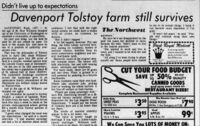1973-04-02-longview-daily-news-p17-tolstoy-farm-survives
April 02, 1973 Longview Daily News Page 17:
Didn't live up to expectations
Davenport Tolstoy farm still survives
DAVENPORT, Wash. (AP)—At the age of 20, Huw Williams dropped out of the University of Washington to establish a community of anarchists.
Do your own thing. Let the land be used by all but owned by none. Go back to the simple life. And have no one in a position of authority over anyone else.
That was the philosophy of Tolstoy farm in April 1963, when Williams’ grandmother gave him 200 acres of land in a remote, wooded canyon near the Lincoln County seat at Davenport.
On the eve of its 10th anniversary, the colony has a population of about 60 of 70, almost half of them children. The makeshift buildings scattered across the landscape give it an appearance faintly reminiscent of the Depression era welfare camps known as Hoovervilles.
And at the age of 30, Williams has dropped out again.
Last December he moved to Airway Heights, a suburb of Spokane, Wash. 35 miles from the farm. He still drives back five days a week to teach at the private, state-approved school, getting $50 a month from Tolstoy parents to pay for gas.
“I guess what changed the most was my expectations,” he said in a recent interview. "I had studied sociology and had a lot of theories about social problems. I felt that with the right social system we could have a utopia with no crime, no violence, no divorce...
“But it didn’t happen.”
A lot did happen, however. For one thing, the little colony survived turnover among its residents, hordes of summer visitors, hostility from its more conservative neighbors and several marijuana raids.
Moreover, much of the original identity remains intact. The homes still lack electricity, hot and cold running water, television and telephones.
For dairy foods, there are 20 goats and two cows. Flour is ground in a mill powered by pedaling on a bicycle mechanism.
Some residents raise their own food. Others take seasonal jobs, picking fruit or working the wheat harvest. A few live off welfare or food stamps.
“People get along amazingly well,” says Bob, identifying himself as a 38-year-old former security officer and dispatcher for the Los Angeles Water Department. "I would say the levels of violence here are a lot lower than out there."
The levels of marital stability appear to be a lot lower, too.
"The farm is pretty rough on marriage if you want a stable-couple family marriage," Williams said. “It’s hard to do there It’s hard to do anywhere.”
He says he’s not disappointed by the past ten years but decided to move because his wife "didn’t want to live in the canyon anymore."
“She wanted to work and live in town, and I wanted to be with her and the kids.
“All along I’ve been trying to phase myself out. Some people have looked to me to do certain things. I think it can become more dependent if I'm gone.
“It won't fall apart,” he said. “People will continue doing their own things.”
